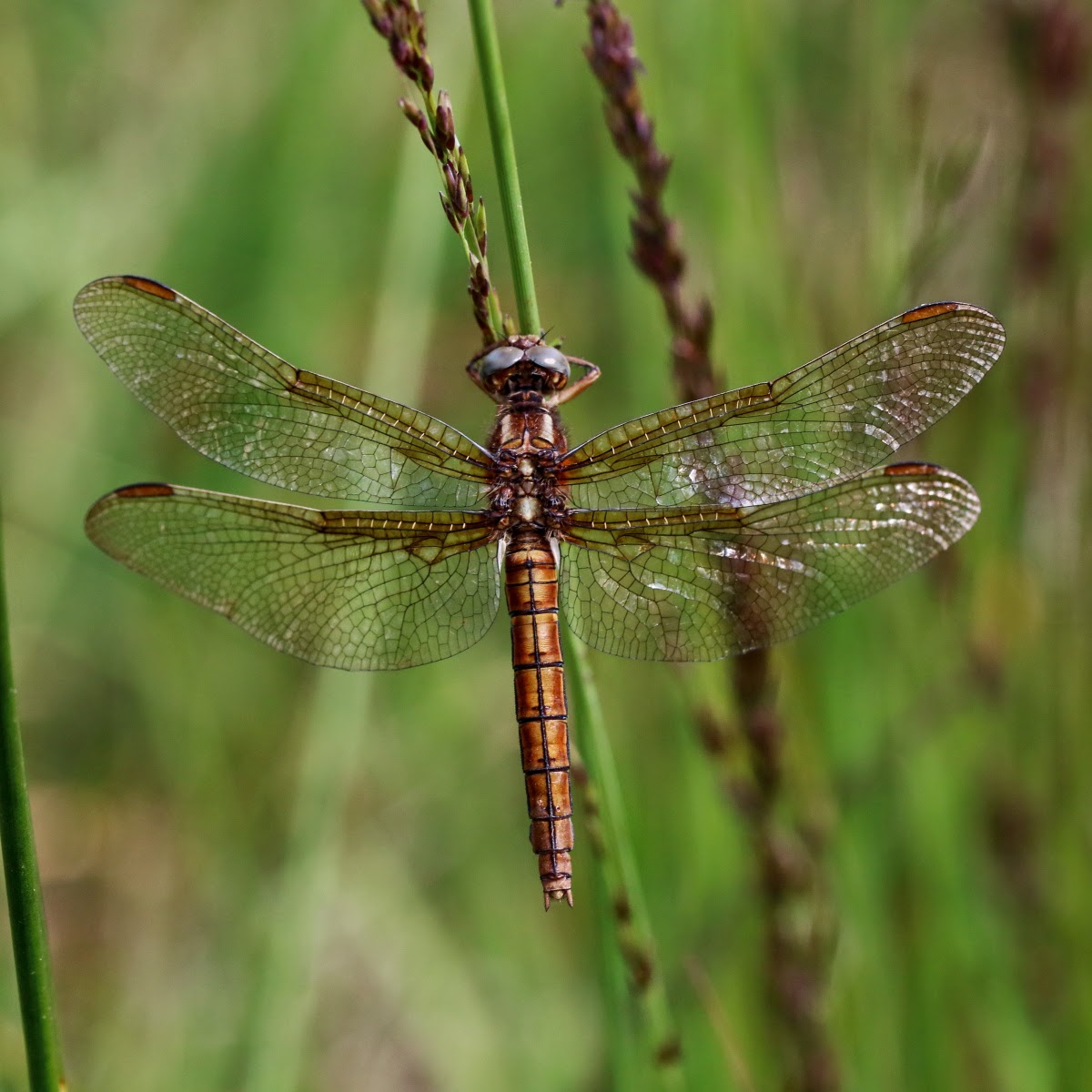A very busy month for moths. As well as the rarities (See Goat and Footman post) there was an abundance of more common species as well as plenty of species new to our moth trap. On the advice of Trevor, who is an old hand at the moth trapping business, we moved our trap further down the garden and ended up with a much bigger catch as a result. Pictures of some of the more photogenic below as well as a full list of the moths seen - not including those that flew out of the trap as soon as it was opened because the weather and their wing muscles were so warm.
In total, it was 124 different species - not including the other insects that also get drawn to light.
 |
| Common Yellow Conch - Agapeta hamana |
7th July
Bright-line Brown-eye
Broad-barred White
Brown Tail
Buff Arches
Buff Ermine
Cinnabar
Common Footman
Common Plume (micro)
Common Yellow Conch (Agapeta hamana - micro)
Coronet
Coxcomb Prominent
Dark Arches
 |
| Coxcomb Prominent - Ptilodon capucina |
Dot moth
Early Thorn
Elephant Hawkmoth
Flame
Flame Shoulder
Heart and Club
Heart and Dart
Herald
L-album Wainscot
Large Yellow Underwing
Lesser Broad-bordered Yellow Underwing
Poplar Hawkmoth
 |
| White Plume - Pterophorus pentadactyla |
Riband Wave
Rosy Footman
Scalloped Oak
Small Grey (Eudonia mercurella - micro)
Small Magpie (micro)
Small White Wave
Smoky Wainscot
Spectacle
Spotted Magpie (Phlyctaenia coronata -
micro)
Suspected
White Plume (not in trap)
Willow Beauty
12th July
 |
| Small Phoenix - Ecliptopera silaceata |
Acorn Piercer (Pammene fasciana - micro)
Bright-line Brown-eye
Buff Arches
Clay
Clouded Silver
Common Bright (Incurvaria oehlmanniella - micro)
Common Rustic
Dark Arches
Dot Moth
Double-square spot
 |
| Mirid Bug - Miridius quadrivirgatus |
Ear Moth
Elephant Hawkmoth (7)
Heart and Club
Heart and Dart
Large Yellow Underwing
Miller
Mother of Pearl - micro
Oak Nycteoline
Rosy Footman
Rosy Tabby (Endotricha flammealis - micro)
Rustic
Satin Grass-veneer (Crambus perlella - micro)
Scalloped Oak
 |
| Buff Arches - Habrosyne pyritoides |
Silver Y
Small Grey (Eudonia mercurella - micro)
Small Phoenix
Treble Brown-spot
Uncertain
Yarrow Plume - micro
Other Insects
Orange Ladybird
Sexton Beetle -
Nicrophorus interruptus
Black Snail Beetle -
Silpha atrata
Mirid Bug -
Miridius quadrivirgatus
21st July
 |
| Peacock - Macaria notata |
Blood Vein
Bright-line Brown-eye
Brimstone
Brown China Mark - micro
Buff Arches
Buff Ermine
Buff-tip
Chinese Character
Clay
Clouded Border
Clouded Silver
Common Footman
 |
| Jersey Tiger - Euplagia quadripunctaria |
Common Quaker
Coxcomb Prominent
Dark Arches
Dark/Grey Dagger
Dot Moth
Drinker
Dusky Pearl (Udea prunalis - micro)
Ear Moth
Early Thorn
Elephant Hawkmoth
European Corn-borer (Ostrinia nubilalis - micro)
Fan-foot
 |
| Notch Wing Tortix - Acleris emargana |
Flame Shoulder
Four-spotted Footman
Garden Grass-veneer (Chrysoteuchia
culmella - micro)
Garden Tiger
Goat Moth
Heart and Dart
Heather Knot-horn (Pempelia palumbella -
micro)
Hebrew Character
Iron Prominent
Jersey Tiger
Least Yellow Underwing
Lesser Broad-bordered Yellow Underwing
Lesser Yellow Underwing
 |
| Blood-vein - Timandra comae |
Lunar-spotted Pinion
Magpie
Maple Prominent
Marbled Piercer (Cydia splendana - micro)
Meal Moth - micro
Mother of Pearl - micro
Notch Wing Tortix (Acleris emargana - micro)
Nut-tree Tussock
Oak Hook-tip
Orthopygia glaucinalis - micro
Pale Prominent
Pale Water-veneer (Donacaula forficella)
Peacock
Pebble Hook-tip
Pebble Prominent
Poplar Hawkmoth
Riband Wave
Ringed China-mark (Parapoynx
stratiotata - micro)
Rosy Footman
Rosy Tabby (Endotricha flammealis - micro)
Ruby Tiger
Scalloped Oak
Scarce Footman
Single-dotted Wave
Small Grey (Eudonia mercurella - micro)
Small Yellow Wave
Smoky Wainscot
Straw Dot
Swallow Prominent
Swallow-tailed Moth
Sycamore
Treble Brown Spot
Triple Striped Piercer (
Grapholita
compositella - micro)
Other Insects
10-spot Ladybird
26th July
 |
| Small Rivulet - Perizoma alchemillata |
Bird-cherry Ermine - micro
Black Arches
Bright-line Brown-eye
Brimstone
Buff Ermine
Canary-shouldered Thorn
Common Footman
Common Purple & Gold (Pyrausta purpuralis - micro)
Common Rustic
Coronet
Dark Arches
Dark Pine Knot-horn (Dioryctria
abietella - micro)
 |
| Marbled Green - Cryphia muralis |
Dingy Footman
Dun-bar
Dusky Thorn
Elephant Hawkmoth
Flame Shoulder
Iron Prominent
Large Yellow Underwing
Lesser Broad-bordered Yellow Underwing
Light Brown Apple Moth (Epiphyas
postvittana - micro)
Long-horned Flat-body (Carcina quercana - micro)
Lunar Thorn
Marbled Green
Oak Hook-tip
 |
| Pine Hawk-moth - Hyloicus pinastri |
Oak Hook-tip
Pale Water-veneer (Donacaula forficella - micro)
Peacock
Peppered Moth
Pine Hawkmoth
Poplar Hawkmoth
Red Twin-spot Carpet
Riband Wave
Ruby Tiger
Ruby Tiger
Sallow
Satin Grass-veneer (Crambus perlella - micro)
Scarce Footman
Shuttle-shaped Dart
Silver Y
Small Rivulet
Small Grey (Eudonia mercurella -
micro)
Straw Dot
Straw Grass-veneer (Agriphila
straminella - micro)
Swallow Prominent
Swallowtail
Sycamore
Tree-lichen Beauty
Twin-spotted Wainscot
Uncertain
Wax Moth
Yellow-tail
Other Insects
Hawthorn Shield-bug



















































